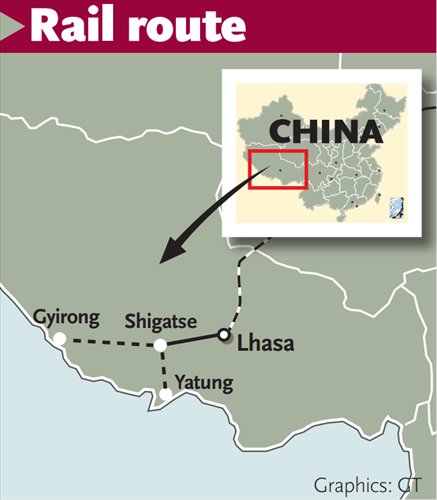‘Sky rail’ to run from Lhasa to south Tibet
Further railway expansion to connect Nepal, Bhutan, India by 2020

Graphics: GT
A railway linking Lhasa and Shigatse in Tibet Autonomous Region, known as the "closest stretch of railway to the sky," is to open to traffic in August after finishing its 14th track test on Tuesday.
The launch of the railway that extends 254 kilometers from Lhasa westward to Shigatse, will be the first in the southwestern area of Tibet.
Construction on the Lhasa-Shigatse line began in September 2010.
It is an extension of the Qinghai-Tibet Railway that runs from Xining, Qinghai Province to Lhasa. It will include 13 stations with altitudes ranging from 3,600 to 4,000 meters.
The trains are expected to run on the extension line at a speed of 120 kilometers per hour.
It is the largest infrastructure project during the 12th Five-Year Plan (2011-2015) with an investment of more than 10.8 billion yuan ($1.7 billion), said Yang Yulin, deputy director of the railway office of the Tibet government.
"It will accelerate transportation of the mineral products, which could only be transmitted through highways that often risk being cut off during rainy seasons or see vehicle turnovers," said Zhu Bin, a manager with a mineral company based in Lhasa told People's Daily.
Soechung, a Tibetan writer based in Lhasa, told the Global Times that the railway will help more local Tibetans get out of their hometowns and exchange with the outside world.
He also said more tourists will be attracted to the area.
Yang revealed that during the 13th Five-Year Plan (2016-2020) period, the construction of a railway connecting Shigatse with Gyirong county, which has checkpoint connecting Nepal and with Yatung county, a trade center bordering India and Bhutan, will start.
Another railway linking Lhasa to Nyingchi in the east is also expected to start construction soon.
Wang Chunhuan, professor at the Tibetan Academy of Social Sciences in Lhasa, told the Global Times on Wednesday that the network will play the role of continental bridge in South Asia and promote economic and cultural exchanges.
She also noted that the development of Shigatse is crucial to boost the development of western Tibetan areas which have been lagging behind.
The railway, apart from boosting economic development, will contribute to solving border disputes between China and India in the South Tibet region, observers say.
According to the Chinese foreign ministry, there are a total of 125,000 square kilometers of disputed area between China and India, of which, 90,000 square kilometers are in the South Tibet region, known as "Arunachal Pradesh" in India.
Liu Zongyi, an expert of Indian studies with the Shanghai Institutes for International Studies, told the Global Times that Indian authorities would certainly care about the operation of the Lhasa-Shigatse Railway that is very close to the disputed area.
"The Indians have lately been working on adding infrastructure in the South Tibet region, in order to strengthen control," said Liu.
"They have been sensitive to how the Chinese government moves in the southwestern area of Tibet," Liu told the Global Times.
"Arunachal Pradesh" was put on India's railway map in April, 2014, though of 27 roads India planned to build in the area, only one is finished so far.
Rajeswari Rajagopalan, a senior fellow at the Observer Research Foundation in New Delhi told The Diplomat in June that "tremendous improvements" China has made over the past decade in linking South Tibet to the rest of the country.
Liu said that the bargaining chips will be increased on the Chinese side if people in the South Tibet region see better economic development in southwestern Tibet.
The growing railway network will increase Chinese activities in this area, balancing Indian moves, Liu said.
The Lhasa-Shigatse railway was built across 90 kilometers of Yarlung Zangbo Grand Canyon and through 29 tunnels.
Yang said that the environment alongside the railway is very fragile and in order to protect the environment, the construction team has transplanted 3,000 square meters of plants and had been using clean energy.